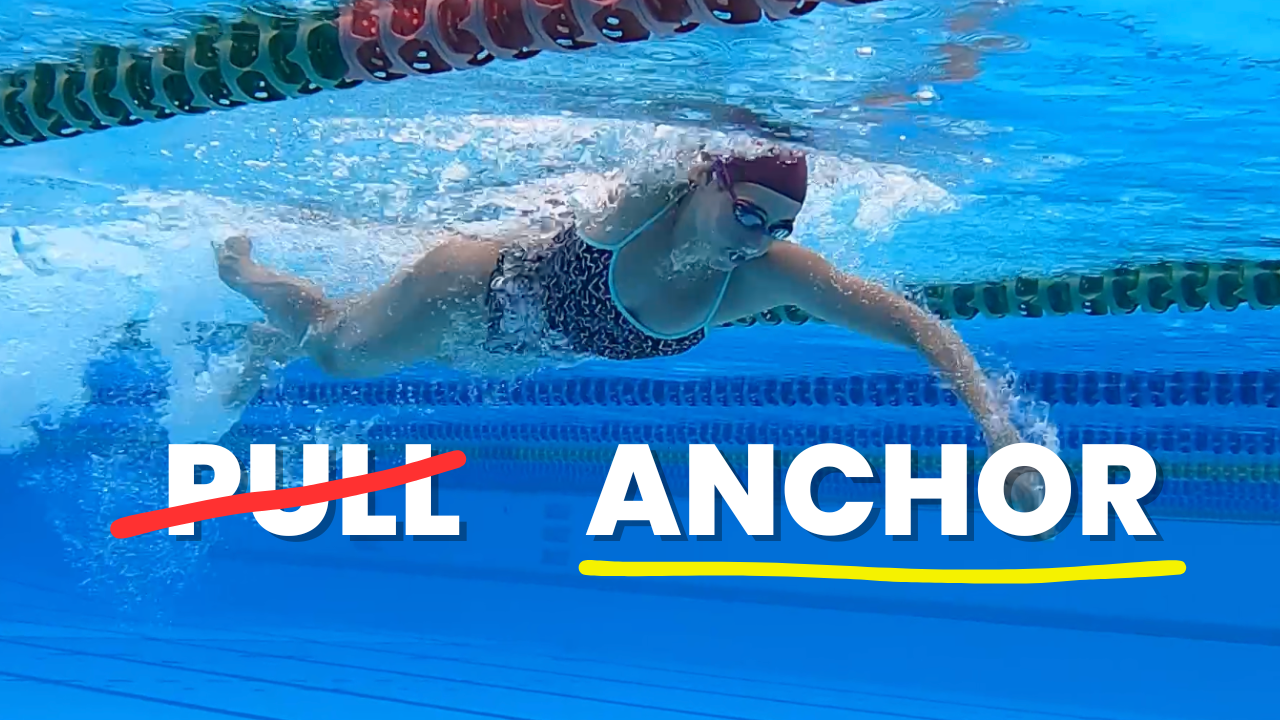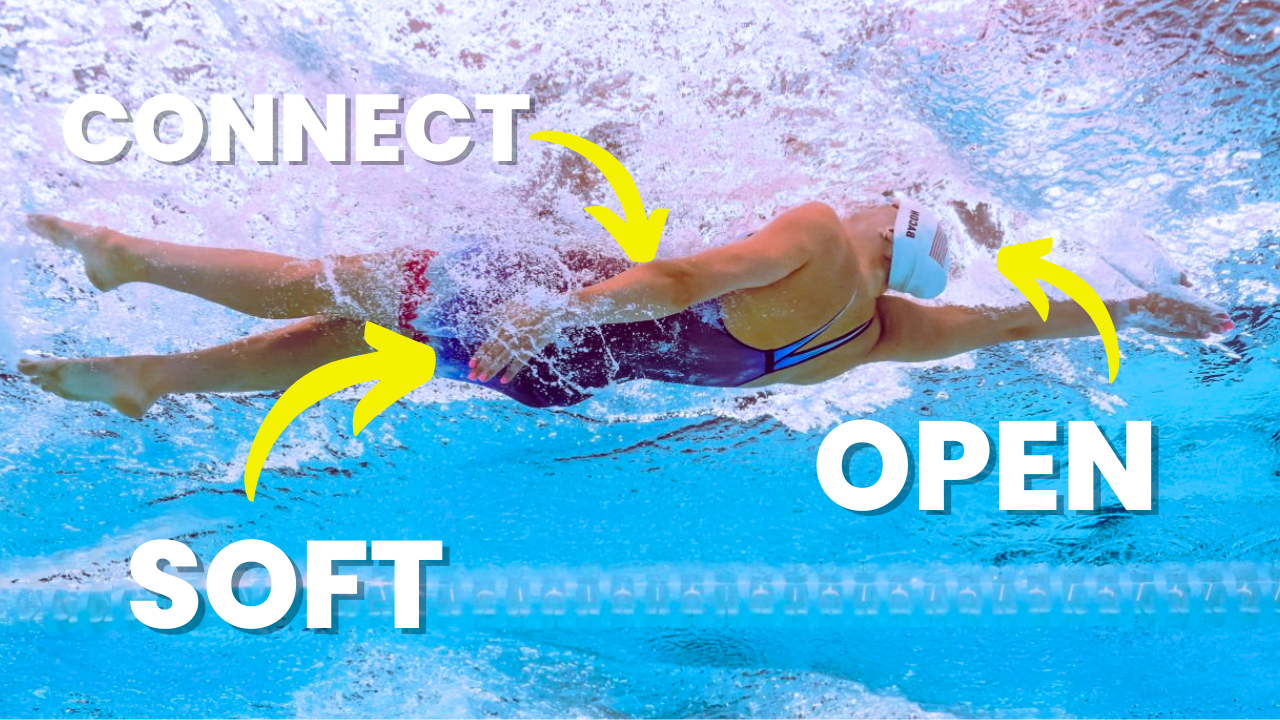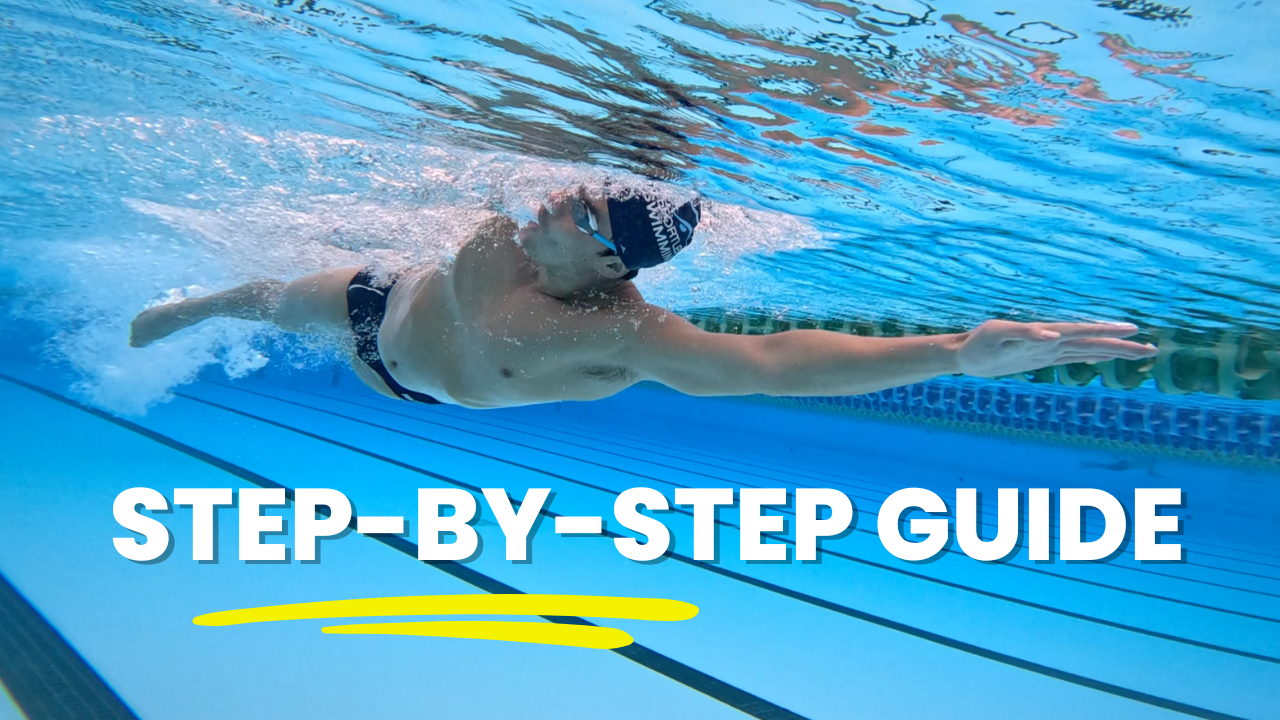This swimmer has three areas that he could develop to help improve his swimming.
1. Exhale earlier
2. Possible 4-beat kick and better core and glute engagement
3. Depth of his hands during the pull phase
Transcription:
If we look at this angle is roughly 155 degrees. So, that just indicates he’s down too deep, arms too straight, so he’s probably not getting as much as he can from there.
Hey, Brenton here from Effortless Swimming. Welcome to Feedback Friday. In today’s video, we are looking at an athlete who’s sent in their video and we’re going to have a look at what are some things that might help him swim faster over the next couple of months. Now, when we follow the five core principles that we’ll be teaching our upcoming video membership, which should be available in the next two weeks, then one of the very first things we look at is the breathing. And, we want to be able to breathe deep and relax as we do it. Part of that is making sure that we inhale and exhale correctly. So, if we look at this swimmer here, particularly when he comes back, you’ll see that as he’s exhaling, there’s a bit of exhalation through the nose, which is good. But just before he goes to take that breath in, he gets a little bit of an exhale but probably not enough.
So, my guess is by the time he turns his head, his mouth’s out of the water and he is ready to take a breath, there’s still a lot of air that’s in his lungs, so he hasn’t fully exhaled. And that can often lead to a build-up of carbon dioxide, which will cause you to basically fatigue and feel tired. But it will also take that little bit longer to be able to get the breath. So, if you’re taking an extra half-a-second to get the breath because you haven’t fully breathed out or fully exhaled by the time that your mouth is out of the water, then it’s just going to mean you’re going to spend a bit longer on your side, which we don’t want to spend longer than we need to on our side here. And when you do that, often you’ll over-rotate through your shoulders and through your hips.
And, one of the things that that causes is for this arm to drop down low. And in this position on your side with the head still out of the water and the arm down here, it’s very difficult to get a good catch. So, working towards that high elbow catch that we talk a lot about. So, one of the first things that this swimmer could potentially do is just make sure he exhales a little bit more or a little bit sooner before his mouth comes out of the water. So, the way that we like to teach it, and you’ve probably seen it in some of the videos, like the one that we’ve linked to above, is you want this light exhale, preferably through the nose. Very light exhale. Then a big puff of air out the mouth or nose. And, then you can get the breath comfortably and it’s like a vacuum. Just inhale and get it fast and you can get that head straight back down to where we want it to be. So that’s the first thing.
The second thing that stands out to me here is the kick. Now, with a lot of our members who send in their videos in the membership, a lot of them have had a two-beat kick. And, as you know there’s nothing wrong with the two-beat kick, but we have found that many swimmers who have gone from a two-beat kick to a four-beat kick have actually found that their times have improved. Their body position improves as well along with it. And, part of that is just from a better body position but also finding a much easier rhythm. So, if you don’t know what a four-beat kick is, have a look at the video above. We recorded one about two months ago on a two-beat, four-beat, and six-beat kick. And, with this [inaudible 00:03:11] there’s that two-beat kick, which basically means that the left hand is pulling through and you would get one kick on that side. Then on the other side, we have one kick. So, it’s basically one kick to one arm stroke.
Now, with the four-beat kick, he’ll probably find that his overall rhythm and fluency improves. But what he’ll probably find too is that he’ll be able to have much better tautness and a little bit of tension through his core and through his hips there. So when you see from behind, there’s a big gap between his knees through the majority of his stroke. And, that often indicates that there’s not the right amount of tautness through the core and engagement through the glutes to really keep this middle section switched on.
So, the way that we like to teach it at clinics and online is, in terms of keeping some tautness through your core, you need to draw your belly button into your spine. So suck your tummy in. You’ve got to squeeze your bum cheeks together a bit. So, engage those glutes slightly. And that’ll give you this nice tension through the center of your body. And that will help you connect up your catch and your pull-through with the rotation of your body all the way through to your kick. Whereas, if we haven’t got that little bit of tension and tautness through here, then sometimes it’s like the arms operating separately to the legs, and you’re not able to sync all of that up as good as you possibly can. And if there’s a big gap, if the width between the knees is a long way apart, then sometimes that shows that that’s not quite in place. So, that’s the other thing that I’d be looking to do.
Now, a drill that you can do to help sort of feel for that correct amount of engagement or tension through there, is if you get a kick-board and put it between your legs like a pool-buoy. And, because a kick-board is obviously so narrow, then you’ve really got to work at keeping it between your legs and having it not slip out. So, it forces you to really get the knees to come in a bit closer and to have that right amount of engagement. So, that’s a handy one that you can use if you feel like, I’m not sure my tension through there is where it should be.
Now, probably the biggest one to me though, that will really help him increase his propulsion is what he’s doing with his arms through the catch and the pull-through. So, if we skip to this front view, this is where it’s probably most evident, but to me there’s not a lot of power or strength through the catch and the pull, because he’s going too deep with the arms and when the arms are in this position, when they’re down too deep, it often can bring the shoulder sort of a long way forwards or with your shoulder blade or your scapula when that’s protracted. So, basically, you can think of it as being forwards and down.
It’s very hard to engage your lats and those stronger shoulder muscles and back muscles through the pull phase. Whereas, if he doesn’t go as deep, if he brings his arm up to somewhere like this, then he’s going to be in this position. He’s going to be a lot more open through the chest. The elbow will be out wider and the lats will really be engaged. And, he’ll be so much more effective, not only with the direction of that force but also the muscles that he’s using through there.
So, we like to look at the angle, and again you’ve probably seen this if you’ve seen many of our other Feedback Friday videos. So, with this swimmer, the angle that we roughly want is somewhere between 100 and 120 degrees in this phase of the stroke here. So, that’s where we’d want to be. That green line. Where he is at the moment, if we look at this angle, is roughly 155 degrees. So, that just indicates he’s down too deep, arms too straight, so he’s probably not getting as much as he can from there.
Similar thing on this left side. Alright, similar angle. Where is he, 143. So, where we’d probably want to be is somewhere like this. And, that will mean the elbows will be out quite a bit more, the hand will be on the inside of that elbow, and that’s when you can really be open through the chest. Lats will be used throughout that phase of the stroke and that direction of the force will be a lot more effective as well. And, that’s really the key one that I’d be looking to focus on.
Now, a drill that may help this swimmer get a feel for the right depth through his stroke is the power diamond drill. And this is where you can kick with ideally a snorkel and fins on, and you can see this video here. Get the arms out where the elbow’s almost flared. They’re out really wide and your hands are on the inside there, and you’re making this diamond shape if we were to look from the front. And, we like to call this the power diamond, and that’s where you’ll see all the really good swimmers with their arms is they’re about to pass underneath their shoulder.
That drill will give him the sense and the awareness around where he should be in that phase of the stroke. So, he might do something like four 50s, 25 power diamond drill, and then 25 swim. And, when he goes into that swim, he’s looking to move through that same position that he was in in the drill. And that’s a good way to make that change there. Because, we know from working with thousands of different swimmers that the perception of what you’re actually doing to what you’re actually doing in the water can be very, very different. So, if you can make sure that you’re in the right position in these drills and you can look and you can check, then you can transfer or translate that into the full stroke. So, if we can bridge the gap from what you think you’re doing to what you’re actually doing, that’s when we really see some improvements made because you’re able to change your stroke.
Whereas if you try and change some things just a tiny bit, more times than not, nothing changes. So, there’s a lot of things in freestyle that you do need to exaggerate in order to change them. So, that’s why it can be really helpful to get some video done. Whether you’ve got a phone, you record yourself with that. If you’ve got an underwater camera like GoPro, like we use, then you can really get a good sense of where you’re actually at. And then when you try and make a change, film yourself, see where you’re at, and that’s a good way to have that feedback.
Now, if you’re looking to have your own videos analyzed, we run clinics all around Australia. We’ll also be in New Zealand in July. We also do online video analysis. So, we have a lot of swimmers from around the world who will send their videos on a regular basis every four to six weeks. And, I do the analysis of their stroke and give them some suggested drills and an action plan to follow to help them make those improvements in their stroke. So, check out the links below. All the details are there. Hope you enjoyed this video. Make sure you share it with someone who you think could benefit from this video. I’ll see you next week with another Feedback Friday. Thanks for watching.









